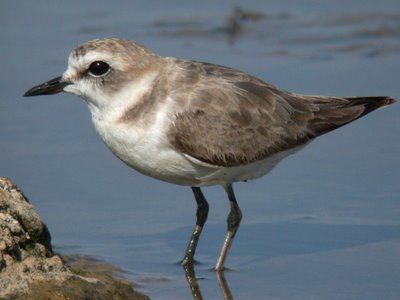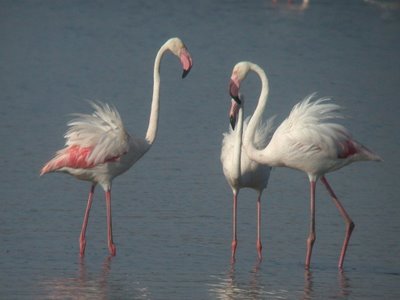Western Andalucia and the Algarve Bird Report 28 June to 7 July 2006.

Eurasian Spoonbill at La Rocina, Coto Donana 30 June 2006 M.J.McGill. Hundreds if not thousands can be found around the El Rocio area when the marshes hold water.
 Female Kentish Plover at Salgado Lagoon, Armacao de Pera, Algarve M.J.McGill. Many species were bleached and worn at this time of year. Dozens of these busy little waders were feeding and breeding around this excellent site. Some were fully fledged and others mere fluffy 'day olds'.
Female Kentish Plover at Salgado Lagoon, Armacao de Pera, Algarve M.J.McGill. Many species were bleached and worn at this time of year. Dozens of these busy little waders were feeding and breeding around this excellent site. Some were fully fledged and others mere fluffy 'day olds'.
 Greater Flamingos at Las Madres de las Marismas (The Mother of the Marshes). Hundreds of flamingo fed near the promenade and about this vast open marsh. It is a great place to sit and watch the much varied ornithological activity. M.J.McGill.
Greater Flamingos at Las Madres de las Marismas (The Mother of the Marshes). Hundreds of flamingo fed near the promenade and about this vast open marsh. It is a great place to sit and watch the much varied ornithological activity. M.J.McGill. After flying with ryanair from Liverpool John Lennon Airport to Seville we collected our hire car and headed for the Old Quarter of Seville. This was a family holiday with no hardcore birding intended but allowing some relaxed birding and visit a few new sites to add to my Iberian knowledge. My third visit to Seville was for with the unanimous intention of waking up next to the cathedral, to wander around at leisure and taste more delectable tapas, I managed all three!
In the park opposite where we stayed I heard overflying parakeets which I thought were Monk Parakeets. House Sparrows were pleasingly common. From the streets around the famous cathedral I noted the Lesser Kestrels busy feeding young, they were highly vocal above our favourite Deli/Cafe and were swooping over tourists who did not even look up. Inside the cathedral I saw a Swift happily flying around, this is the second time I have seen them on the interior, I hope they get out now and again!
From the Giralda Tower you are offered stupendous views over the city, Guadalquivir River and beyond. Also from here you can look down onto the large Lesser Kestrel colony that has probably nested here since it was completed in 1506. A White Stork also landed on one of the elaborately carved masonry towers.
Back on the road and into Donana National and Natural Park to stay at El Rocio for my fifth visit. Black Kites and White Storks were common with the latter nesting on pylons everwhere. Bee Eaters are seen in numbers everwhere, Woodchat Shrikes very common (most had fledged young) and Azure Winged Magpies flew across the road every few minutes. The El Madre Lagoon opposite the town held 10+ Black Kite, 3 Marsh Harrier, 300+ Avocet, 700+ Black-tailed Godwit, 200+ Spoonbill, 400+ Greater Flamingo, 8+ Purple Heron, 4+ Grey Heron, lots of Mallard and Pochard broods, 30+ Black-winged Stilt, Reed Warbler, 10+ White Stork and Hobby over. Not bad for 20 minutes.
El Madre Lagoon 30 June 2006 A morning visit to add a few more birds included 20+ Collared Pratincole, 4 Gull- Billed Tern, a female Little Bittern, 1 Squacco Heron, 1 Night Heron, juvenile Black Tern, Cattle Egrets, Booted Eagle, Redshank, Lapwing and more of the common Mediterranean passerines.
A visit to the beach was refreshing and I did watch at close range two Red-rumped Swallows feeding around the car park at Torre de la Higuera. This species is seen regularly along the highways near bridges and culverts. A quick visit to El Acebuche to check out some details saw the regular crowd of 40+ Azure-winged Magpie hanging around the picnic area. On the way 'home' we saw Southern Grey Shrike and 30+ Bee Eater. Back at El Rocio in the evening 300+ Spoonbill and 9 Purple Heron were counted along with the usual throng of waterbirds.
La Rocina 2000-2100. Looking from the cool hides in the late evening a selection of Black-winged Stilts, Little- ringed Plover, Woodchat Shrike, White Stork and Spoonbills all had young. They were joined by 10 Green Sandpiper, 2 Savi's Warbler, 1 Olivaceous Warbler and a Purple Swamp Hen.
1 July 2006 An earlier but not that early start for me, heading out into the northern marismas and eventually to the CV Jose Antonio Valverde Centre and Lucio del Lobo. On the way I saw a Stone Curlew and on arrival a single Great White Egret, Great Reed Warblers, BW Stilts and Little and Cattle Egrets. At the centre it was drier than my last visit two years ago so not quite as good. Around 40,000 waterbirds were present last time. A male Pin-tailed Sandgrouse flew over. The heronry was still as busy with fledged young everwhere. The smell and sound of hundreds of Glossy Ibis, Cattle and Little Egrets, Squacco, Night and Purple Herons was as ever amazing.
A different route back without hanging about added 15 Night Heron, 100,s Calandra and Short-toed Larks and Southern Grey Shrike from the car.
Dehesa de la Abajo This was a new site for me and proved impressive due to the drier conditions around the park. An estimate of 2000 Black-winged Stilt, 100,s-1000 Whiskered Tern, 500 Avocet, 40 Black Kite, Marsh Harrier, 50 Black-necked Grebe, 3000 Coot, a pair of Ruff, 2000 Black-tailed Godwit, 100,s White Stork (breeding), 100 Bee Eater, 400 Spoonbill and many wildfowl. More time was needed to search through them all, what a site. I was only out for three hours and it was a pity to leave. Most of my birding was from the car hence not getting better views and hearing more species. I did have poors views of Spectacled Warbler and would have seen many other birds if I had time to search. I have seen them before and will see them again.
From the 1-7 July we stayed near Armacao de Pera on the Algarve, Portugal.
Some notable sightings while out and about included 6+ Alpine Swift racing around the seafront at Albufeira, Short-toed Eagle on the way to Monchique and looking down on Pallid Swifts at Ponta da Piedade. Yellow legged Gulls were numerous all along the coast.
I did visit the wetland site at Vilamoura briefly to have a look at any new developments. Much of it was closed off to cars now, I suppose local revheads have spoiled it for all. Purple Heron were still numerous and the reservoir lagoons held numerous Pochard, Mallard, Gadwall, Black-necked Grebe, Yellow -legged Gull and Black-winged Stilts. Cattle Egrets were also seen with White Storks, Waxbills, Marsh Harrier, Hoopoe, Turtle Dove, Azure- winged Magpies and Woodchat Shrikes around the scrub and reedbeds. As I was there at the middle of the day no Purple Swamp Hen were seen and this was a good site for Red-necked Nightjar five years ago.
From our rural apartment I was fortunate enough to have breeding Bee Eaters, Woodchat Shrike, Hoopoe, Sardinian Warbler, Red-rumped Swallow and also noted an Alpine Swift and Booted Eagle, most were seen from the breakfast table.
My local patch was the Salgado lagoon which I birded five times totalling about 5 hours. This impressive site held various numbers of birds but peaks of 217 Greater Flamingo, 9 Spoonbill, 150-200 Avocet, 100 pairs Black-winged Stilt, 30 Little Grebe, Moorhen, 400 Coot, 100 Kentish Plover, up to 25 Dunlin, 1 Curlew Sandpiper (6th), up to 4 Common Sandpiper, Pallid and Common Swift, 30 Little Egret, 8 Grey Heron, 30 Cattle Egret, 250-380 Black-tailed Godwit, Green Sandpiper, 50 Little Tern, 4 Gull-billed Tern, 10 Sandwich Tern, 150 Mallard, breeding Gadwall, 5 Purple Swamp Hen, 2 short staying Slender-billed Gull (adults on 6th), a roosting adult Audouin's Gull (6th), a Great Black-backed Gull (6th), 2 Purple Heron (7th), 2 Zitting Cisticola, 15 Crested Lark, Thekla Lark, 2 Little Owl, 1 Hoopoe, 10 Woodchat Shrike and 10 Pochard.
On the return to Seville I wanted to check another new Spanish site for me, El Portil Lagoon near Punta Umbria. It was a sunken lagoon within a dune system but adjacent to the town of El Portil. Many birds were present 1000 Coot, 6 Spoonbill, 1 Black-tailed Godwit, Great Crested and Little Grebes, 20 Pochard, 2 Red-crested Pochard, 20+ Little-ringed Plover, 30+ Black-winged Stilt, Sardinian Warbler, Sand Martin and Common Sandpiper but no target species of Chamaeleon.
<< Home